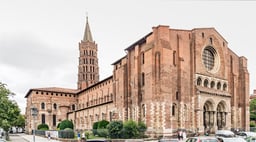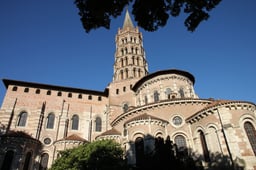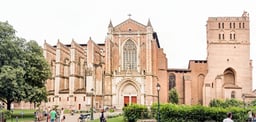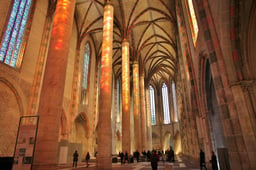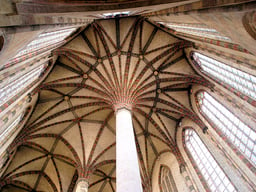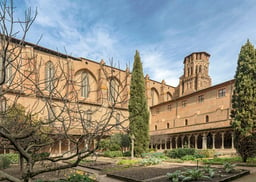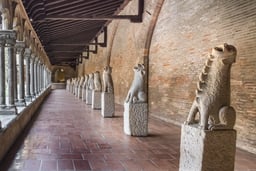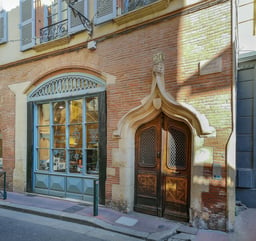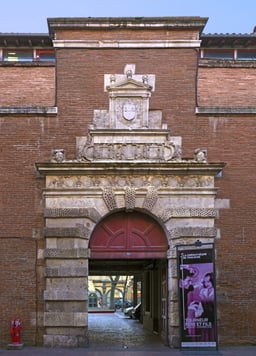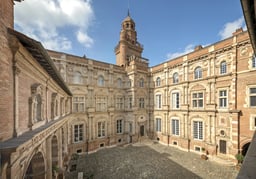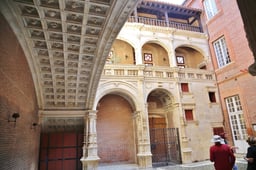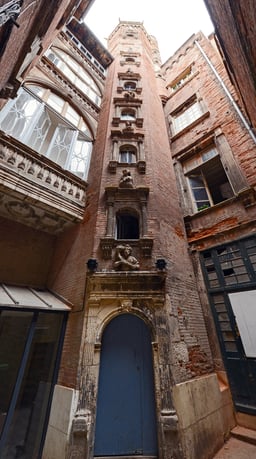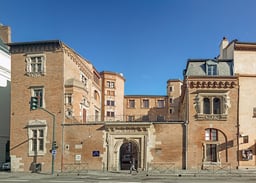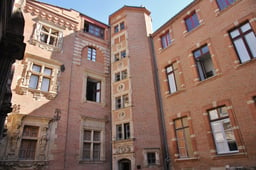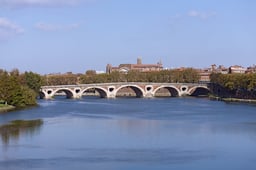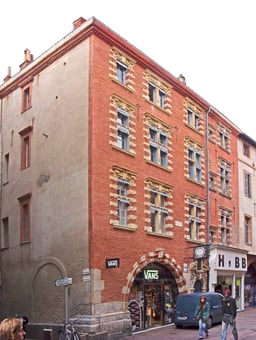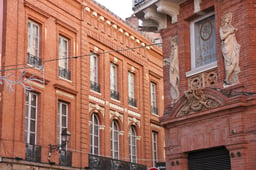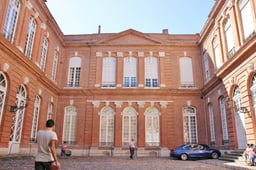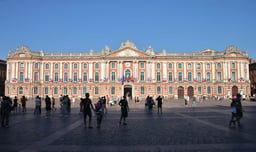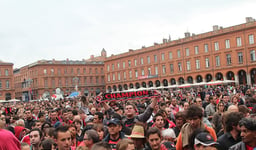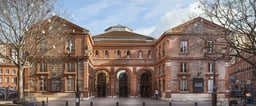Toulouse
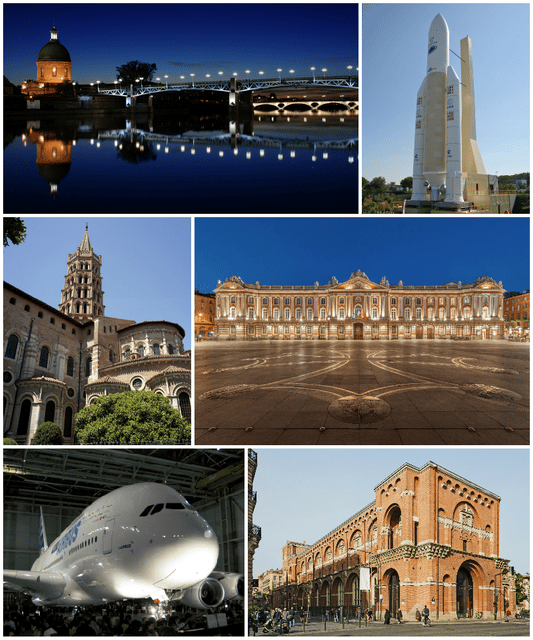
Toulouse

Toulouse Tolosa(Occitan) | |
|---|---|
Prefecture and commune | |
| Motto(s): Per Tolosa totjorn mai (Occitan for "For Toulouse, always more") | |
Location of Toulouse | |
| Coordinates:43°36′16″N 1°26′38″E [48] | |
| Country | France |
| Region | Occitanie |
| Department | Haute-Garonne |
| Arrondissement | Toulouse |
| Canton | Toulouse-1, 2, 3, 4, 5, 6, 7, 8, 9, 10 and 11 |
| Intercommunality | Toulouse Métropole |
| Government | |
| • Mayor(2014–2020) | Jean-Luc Moudenc (LR) |
| Area 1 | 118.3 km2(45.7 sq mi) |
| • Urban (2010) | 811.60 km2(313.36 sq mi) |
| • Metro (2010) | 5,381.49 km2(2,077.80 sq mi) |
| Population (2016-01-01)[1] | 482,738 |
| • Rank | 4th in France |
| • Density | 4,100/km2(11,000/sq mi) |
| • Urban (Jan. 2013) | 948,433[2] |
| • Metro (Jan. 2013) | 1,330,954[3] |
| Demonym(s) | English: Toulousian French: Toulousain(e) Occitan: tolosenc(a) |
| Time zone | UTC+01:00 (CET) |
| • Summer (DST) | UTC+02:00 (CEST) |
| INSEE/Postal code | 31555 [49] / |
| Website | www.toulouse.fr [50] |
| 1French Land Register data, which excludes lakes, ponds, glaciers > 1 km2(0.386 sq mi or 247 acres) and river estuaries. | |
Toulouse (/tuːˈluːz/,[4] French: [tuluz] (listen); Occitan: Tolosa [tuˈluzɔ]; Latin: Tolosa) is the capital of the French department of Haute-Garonne and of the region of Occitanie. The city is on the banks of the River Garonne, 150 kilometres (93 miles) from the Mediterranean Sea, 230 km (143 mi) from the Atlantic Ocean and 680 km (420 mi) from Paris. It is the fourth-largest city in France, with 466,297 inhabitants as of January 2014. In France, Toulouse is called the "Pink City" (La Ville Rose).
Toulouse is the centre of the European aerospace industry, with the headquarters of Airbus (formerly EADS), the SPOT satellite system, ATR and the Aerospace Valley. It also hosts the European headquarters of Intel and CNES's Toulouse Space Centre (CST), the largest space centre in Europe.[5] Thales Alenia Space, ATR, SAFRAN, Liebherr-Aerospace and Airbus Defence and Space also have a significant presence in Toulouse.
The city was the capital of the Visigothic Kingdom in the 5th century and the capital of the province of Languedoc in the Late Middle Ages and early modern period (provinces were abolished during the French Revolution), making it the unofficial capital of the cultural region of Occitania (Southern France). It is now the capital of the Occitanie region, the second largest region in Metropolitan France.
A city with unique architecture made of pinkish terracotta bricks, which earned it the nickname la Ville Rose ("the Pink City"), Toulouse counts two UNESCO World Heritage Sites, the Canal du Midi (designated in 1996 and shared with other cities), and the Basilica of St. Sernin, the largest remaining Romanesque building in Europe,[11] designated in 1998 because of its significance to the Santiago de Compostela pilgrimage route.
Toulouse Tolosa(Occitan) | |
|---|---|
Prefecture and commune | |
| Motto(s): Per Tolosa totjorn mai (Occitan for "For Toulouse, always more") | |
Location of Toulouse | |
| Coordinates:43°36′16″N 1°26′38″E [48] | |
| Country | France |
| Region | Occitanie |
| Department | Haute-Garonne |
| Arrondissement | Toulouse |
| Canton | Toulouse-1, 2, 3, 4, 5, 6, 7, 8, 9, 10 and 11 |
| Intercommunality | Toulouse Métropole |
| Government | |
| • Mayor(2014–2020) | Jean-Luc Moudenc (LR) |
| Area 1 | 118.3 km2(45.7 sq mi) |
| • Urban (2010) | 811.60 km2(313.36 sq mi) |
| • Metro (2010) | 5,381.49 km2(2,077.80 sq mi) |
| Population (2016-01-01)[1] | 482,738 |
| • Rank | 4th in France |
| • Density | 4,100/km2(11,000/sq mi) |
| • Urban (Jan. 2013) | 948,433[2] |
| • Metro (Jan. 2013) | 1,330,954[3] |
| Demonym(s) | English: Toulousian French: Toulousain(e) Occitan: tolosenc(a) |
| Time zone | UTC+01:00 (CET) |
| • Summer (DST) | UTC+02:00 (CEST) |
| INSEE/Postal code | 31555 [49] / |
| Website | www.toulouse.fr [50] |
| 1French Land Register data, which excludes lakes, ponds, glaciers > 1 km2(0.386 sq mi or 247 acres) and river estuaries. | |
Geography
Toulouse is in the south of France, north of the department of Haute-Garonne, on the axis of communication between the Mediterranean Sea and the Atlantic Ocean.
Hydrography
The city is traversed by the Canal de Brienne, the Canal du Midi and the rivers Garonne, Touch and Hers-Mort.
Climate
Toulouse has a humid subtropical climate (borderline Cfa/Cfb in the Köppen climate classification), with too much precipitation in the summer months preventing the city from being classified as a Mediterranean climate zone.
| Climate data for Toulouse (TLS), elevation: 151 m (495 ft), 1981–2010 normals, extremes 1947–present | |||||||||||||
|---|---|---|---|---|---|---|---|---|---|---|---|---|---|
| Month | Jan | Feb | Mar | Apr | May | Jun | Jul | Aug | Sep | Oct | Nov | Dec | Year |
| Record high °C (°F) | 21.2 (70.2) | 24.1 (75.4) | 27.1 (80.8) | 30.0 (86.0) | 33.4 (92.1) | 40.2 (104.4) | 40.2 (104.4) | 40.7 (105.3) | 35.3 (95.5) | 30.8 (87.4) | 24.3 (75.7) | 21.1 (70.0) | 40.7 (105.3) |
| Average high °C (°F) | 9.5 (49.1) | 11.1 (52.0) | 14.5 (58.1) | 17.0 (62.6) | 21.0 (69.8) | 25.2 (77.4) | 28.0 (82.4) | 27.9 (82.2) | 24.6 (76.3) | 19.5 (67.1) | 13.3 (55.9) | 9.9 (49.8) | 18.5 (65.3) |
| Daily mean °C (°F) | 5.9 (42.6) | 7.0 (44.6) | 9.8 (49.6) | 12.1 (53.8) | 16.0 (60.8) | 19.7 (67.5) | 22.3 (72.1) | 22.2 (72.0) | 19.0 (66.2) | 15.0 (59.0) | 9.5 (49.1) | 6.5 (43.7) | 13.8 (56.8) |
| Average low °C (°F) | 2.4 (36.3) | 3.0 (37.4) | 5.0 (41.0) | 7.1 (44.8) | 10.9 (51.6) | 14.3 (57.7) | 16.5 (61.7) | 16.5 (61.7) | 13.4 (56.1) | 10.5 (50.9) | 5.8 (42.4) | 3.2 (37.8) | 9.1 (48.4) |
| Record low °C (°F) | −18.6 (−1.5) | −19.2 (−2.6) | −8.4 (16.9) | −3.0 (26.6) | −0.8 (30.6) | 4.0 (39.2) | 7.6 (45.7) | 5.5 (41.9) | 1.9 (35.4) | −3.0 (26.6) | −7.5 (18.5) | −12.0 (10.4) | −19.2 (−2.6) |
| Average precipitation mm (inches) | 51.3 (2.02) | 41.6 (1.64) | 49.1 (1.93) | 69.6 (2.74) | 74.0 (2.91) | 60.3 (2.37) | 37.7 (1.48) | 46.8 (1.84) | 47.4 (1.87) | 57.0 (2.24) | 51.1 (2.01) | 52.4 (2.06) | 638.3 (25.13) |
| Average precipitation days(≥ 1.0 mm) | 9.2 | 7.8 | 8.6 | 9.6 | 9.9 | 7.1 | 5.0 | 6.1 | 6.5 | 8.1 | 9.2 | 8.6 | 95.7 |
| Average snowy days | 2.1 | 2.0 | 1.0 | 0.2 | 0.0 | 0.0 | 0.0 | 0.0 | 0.0 | 0.0 | 0.6 | 1.6 | 7.5 |
| Average relative humidity (%) | 87 | 82 | 77 | 76 | 76 | 72 | 68 | 71 | 74 | 81 | 85 | 88 | 78 |
| Mean monthly sunshine hours | 92.5 | 115.0 | 175.1 | 186.1 | 209.2 | 227.6 | 252.6 | 238.8 | 204.0 | 149.2 | 96.0 | 85.3 | 2,031.3 |
| Source #1: Meteo France[12][13] | |||||||||||||
| Source #2: Infoclimat.fr (relative humidity 1961–1990)[14] | |||||||||||||
| Climate data for Toulouse–Francazal, elevation: 164 m (538 ft), 1981–2010 normals, extremes 1922–present | |||||||||||||
|---|---|---|---|---|---|---|---|---|---|---|---|---|---|
| Month | Jan | Feb | Mar | Apr | May | Jun | Jul | Aug | Sep | Oct | Nov | Dec | Year |
| Record high °C (°F) | 23.3 (73.9) | 24.8 (76.6) | 28.3 (82.9) | 29.9 (85.8) | 33.9 (93.0) | 39.3 (102.7) | 40.2 (104.4) | 44.0 (111.2) | 36.0 (96.8) | 35.4 (95.7) | 27.0 (80.6) | 26.9 (80.4) | 44.0 (111.2) |
| Average high °C (°F) | 9.7 (49.5) | 11.1 (52.0) | 14.5 (58.1) | 16.9 (62.4) | 20.9 (69.6) | 25.0 (77.0) | 28.0 (82.4) | 28.0 (82.4) | 24.6 (76.3) | 19.5 (67.1) | 13.4 (56.1) | 10.1 (50.2) | 18.5 (65.3) |
| Daily mean °C (°F) | 6.1 (43.0) | 7.2 (45.0) | 9.9 (49.8) | 12.2 (54.0) | 16.1 (61.0) | 19.8 (67.6) | 22.4 (72.3) | 22.3 (72.1) | 19.1 (66.4) | 15.2 (59.4) | 9.7 (49.5) | 6.8 (44.2) | 13.9 (57.0) |
| Average low °C (°F) | 2.6 (36.7) | 3.3 (37.9) | 5.4 (41.7) | 7.4 (45.3) | 11.3 (52.3) | 14.7 (58.5) | 16.8 (62.2) | 16.7 (62.1) | 13.7 (56.7) | 10.8 (51.4) | 6.1 (43.0) | 3.4 (38.1) | 9.4 (48.9) |
| Record low °C (°F) | −19.0 (−2.2) | −16.7 (1.9) | −7.4 (18.7) | −4.1 (24.6) | 0.1 (32.2) | 4.5 (40.1) | 7.0 (44.6) | 7.3 (45.1) | 0.0 (32.0) | −2.6 (27.3) | −8.5 (16.7) | −13.4 (7.9) | −19.0 (−2.2) |
| Average precipitation mm (inches) | 50.4 (1.98) | 38.5 (1.52) | 45.9 (1.81) | 65.7 (2.59) | 73.7 (2.90) | 58.0 (2.28) | 38.5 (1.52) | 42.7 (1.68) | 51.9 (2.04) | 55.4 (2.18) | 52.4 (2.06) | 52.5 (2.07) | 625.6 (24.63) |
| Average precipitation days(≥ 1.0 mm) | 8.5 | 7.1 | 8.2 | 10.0 | 9.6 | 7.0 | 4.9 | 6.2 | 6.3 | 8.2 | 8.8 | 8.7 | 93.4 |
| Average snowy days | 2.1 | 2.0 | 1.0 | 0.2 | 0.0 | 0.0 | 0.0 | 0.0 | 0.0 | 0.0 | 0.6 | 1.6 | 7.5 |
| Average relative humidity (%) | 87 | 82 | 77 | 76 | 76 | 72 | 68 | 71 | 74 | 81 | 85 | 88 | 78 |
| Mean monthly sunshine hours | 93.1 | 116.6 | 173.6 | 186.7 | 207.5 | 224.8 | 246.8 | 234.9 | 202.5 | 147.9 | 94.9 | 85.4 | 2,014.5 |
| Source: Meteo France[15] | |||||||||||||
History
Early history
The Garonne Valley was a central point for trade between the Pyrenees, the Mediterranean and the Atlantic since at least the Iron Age. The historical name of the city, Tolosa (Τολῶσσα in Greek, and of its inhabitants, the Tolosates, first recorded in the 2nd century BC), it is of unknown meaning or origin, possibly from Aquitanian, or from Iberian,[16] but has also been connected to the name of the Gaulish Volcae Tectosages.[17]
Tolosa enters the historical period in the 2nd century BC, when it became a Roman military outpost. After the conquest of Gaul, it was developed as a Roman city of Gallia Narbonensis. In the 5th century, Tolosa fell to the Visigothic kingdom and became one of its major cities, in the early 6th century even serving as its capital, before it fell to the Franks under Clovis in 507 (Battle of Vouillé). From this time, Toulouse was the capital of Aquitaine within the Frankish realm.
In 721, Duke Odo of Aquitaine defeated an invading Umayyad Muslim army at the Battle of Toulouse. Odo's victory was a small obstacle to Muslim expansion into Christian Europe, and Muslims finally occupied a large territory including Poitiers. Charles Martel, a decade later, won the Battle of Tours, also called the Battle of Poitiers.
The Frankish conquest of Septimania followed in the 750s, and a quasi-independent County of Toulouse emerged within the Carolingian sub-kingdom of Aquitaine by the late 8th century. The Battle of Toulouse of 844, pitting Charles the Bald against Pepin II of Aquitaine, was key in the Carolingian Civil War.
County of Toulouse

Raymond IV, Count of Toulouse was a leader of the First Crusade
The town became the capital of the County of Toulouse during the Carolingian era.
The Dominican Order was founded in Toulouse in 1215 by Saint Dominic in the context of struggle against the Cathar heresy.
In the Treaty of Paris of 1229, Toulouse formally submitted to the crown of France. The county's sole heiress Joan was engaged to Alphonse, Count of Poitiers, a younger brother of Louis IX of France. The marriage became legal in 1241, but it remained childless so that after Joan's death the county fell to the crown of France by inheritance. Also in 1229, University of Toulouse was established after the Parisian model, intended as a means to dissolve the heretic movement.
Various monastic orders, like the congregation of the order of frères prêcheurs, were started. They found home in Les Jacobins. In parallel, a long period of inquisition began inside the Toulouse walls. The fear of repression obliged the notabilities to exile, or to convert themselves. The inquisition lasted nearly 400 years, making Toulouse its capital. Count Raimond VII was convicted of heresy and died in 1249 without an heir.
Within the Kingdom of France
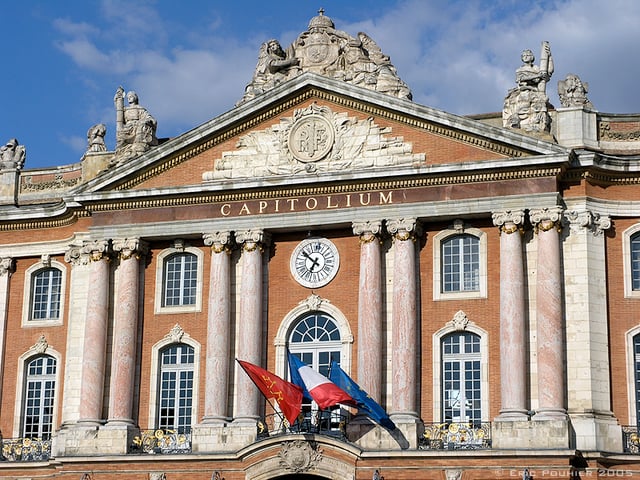
The Capitole de Toulouse, Toulouse's city hall, is an example of the 18th-century architectural projects in the city.
In 1271, Toulouse was incorporated into the kingdom of France and declared a "royal city". In 1323 the Consistori del Gay Saber was established in Toulouse to preserve the lyric art of the troubadours. Toulouse became the centre of Occitan literary culture for the next hundred years; the Consistori was last active in 1484.
The 14th century brought a pogrom against Toulouse's Jewish population by Crusaders in 1320,[18] the Black Death in 1348, then the Hundred Years' War. Despite strong immigration, the population lost 10,000 inhabitants in 70 years. By 1405 Toulouse had only 19,000 people.[19]
The situation improved in the 15th century.[20] Charles VII established a parliament. Reinforcing its place as an administrative center, the city grew richer, participating in the trade of Bordeaux wine with England, as well as cereals and textiles. A primary source of income was the production and export of pastel, a blue dye made from woad.[21]
Within the French Republic
The Battle of Toulouse (1814) was one of the final battles of the Napoleonic Wars, four days after Napoleon's surrender of the French Empire to the nations of the Sixth Coalition. Toulouse, the regional capital, proved stoutly defended by Marshal Soult.
Population
| Historical population | ||||
|---|---|---|---|---|
| Urban Area | Metropolitan Area | |||
| 1695 | 43,000 | |||
| 1750 | 48,000 | |||
| 1790 | 52,863 | |||
| 1801 | 50,171 | |||
| 1831 | 59,630 | |||
| 1851 | 95,277 | |||
| 1872 | 126,936 | |||
| 1911 | 149,000 | |||
| 1936 | 213,220 | |||
| 1946 | 264,411 | |||
| 1954 | 268,865 | |||
| 1962 | 329,044 | |||
| 1968 | 439,764 | 474,000 | ||
| 1975 | 509,939 | 585,000 | ||
| 1982 | 541,271 | 645,000 | ||
| 1990 | 650,336 | 797,373 | ||
| 1999 | 761,090 | 964,797 | ||
| 2006 | 851,947 | 1,169,865 | ||
| 2015 | 948,433 | 1,330,954 | ||
The population of the city proper (French: commune) was 479,638 at the January 2015 census,[22] with 1,330,954 inhabitants in the metropolitan area (within the 2010 borders of the metropolitan area), up from 1,169,865 at the January 2006 census (within the same 2010 borders of the metropolitan area).[3] Thus, the metropolitan area registered a population growth rate of +1.5% per year between 2006 and 2011, the highest growth rate of any French metropolitan area larger than 500,000 inhabitants, although it is slightly lower than the growth rate registered between the 1999 and 2006 censuses.
Toulouse is the fourth largest city in France, after Paris, Marseille and Lyon, and the fourth-largest metropolitan area after Paris, Lyon, and Marseille.
Fueled by booming aerospace and high-tech industries, population growth of +1.49% a year in the metropolitan area in the 1990s (compared with +0.37% for metropolitan France), and a record +1.87% a year in the early 2000s (+0.68% for metropolitan France), which is the highest population growth of any French metropolitan area larger than 500,000 inhabitants, means the Toulouse metropolitan area overtook Lille as the fourth-largest metropolitan area of France at the 2006 census.
A local Jewish group estimates there are about 2,500 Jewish families in Toulouse. A Muslim association has estimated there are some 35,000 Muslims in town.[23]
Government and politics
Toulouse Métropole
The Community of Agglomeration of Greater Toulouse (Communauté d'agglomération du Grand Toulouse) was created in 2001 to better coordinate transport, infrastructure and economic policies between the city of Toulouse and its immediate independent suburbs. It succeeds a previous district which had been created in 1992 with fewer powers than the current council. It combines the city of Toulouse and 24 independent communes, covering an area of 380 km2 (147 sq mi), totalling a population of 583,229 inhabitants (as of 1999 census), 67% of whom live in the city of Toulouse proper. As of February 2004 estimate, the total population of the Community of Agglomeration of Greater Toulouse was 651,209 inhabitants, 65.5% of whom live in the city of Toulouse. Due to local political feuds, the Community of Agglomeration only hosts 61% of the population of the metropolitan area, the other independent suburbs having refused to join in. Since 2009, the Community of agglomeration has become an urban community (in French: communauté urbaine). This has become a métropole in 2015, spanning 37 communes.[24]
Local politics
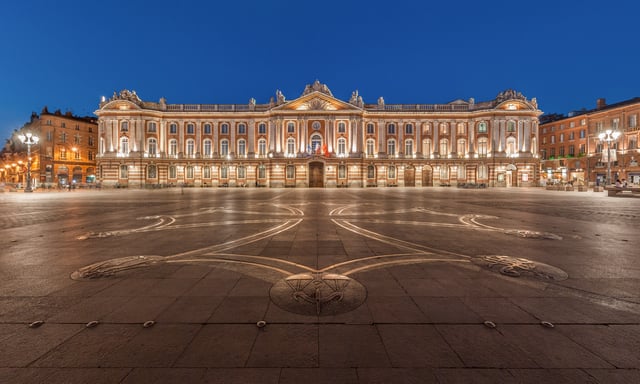
Toulouse's city hall, the Capitole de Toulouse, and the square of the same name with the Occitan cross designed by Raymond Moretti on the ground
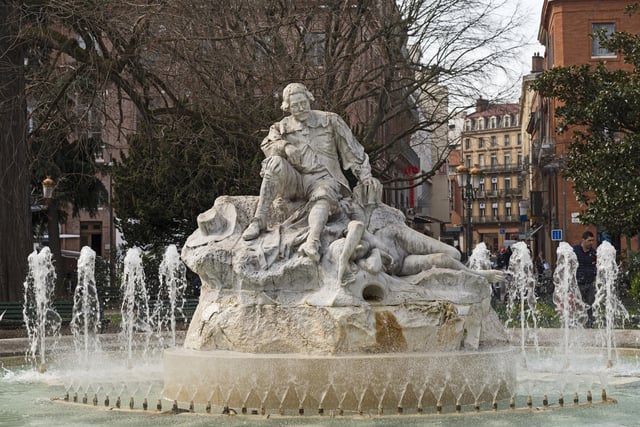
The fountain in Wilson Square (Place du Président Thomas Wilson) shows the poet Pèire Godolin
One of the major political figures in Toulouse was Dominique Baudis, the mayor of Toulouse between 1983 and 2001, member of the centrist UDF. First known as a journalist famous for his coverage of the war in Lebanon, 36-year-old Dominique Baudis succeeded his father Pierre Baudis in 1983 as mayor of Toulouse. (Pierre Baudis was mayor from 1971 to 1983.) The Baudis dynasty succeeded in turning Toulouse into a center-right stronghold, whereas historically the city had been left-leaning since the 19th century.
During his time as mayor, Toulouse's economy and population boomed. He tried to strengthen the international role of Toulouse (such as its Airbus operations), as well as revive the cultural heritage of the city. The Occitan cross, flag of Languedoc and symbol of the counts of Toulouse, was chosen as the new flag of the city, instead of the traditional coat of arms of Toulouse (which included the fleur de lis of the French monarchy). Many cultural institutions were created, in order to attract foreign expatriates and emphasise the city's past. For example, monuments dating from the time of the counts of Toulouse were restored, the city's symphonic concert hall (Halle aux Grains) was refurbished, a city theater was built, a Museum of Modern Art was founded, the Bemberg Foundation (European paintings and bronzes from the Renaissance to the 20th century) was established, a huge pop music concert venue (Zénith, the largest in France outside Paris) was built, the space museum and educational park Cité de l'Espace was founded, etc.
To deal with growth, major housing and transportation projects were launched. Line A of the underground was opened in 1993, and line B opened in 2007. The creation of a system of underground car parking structures in Toulouse city centre was sharply criticised by the Green Party.[25]
In 2000, Dominique Baudis was at the zenith of his popularity, with approval rates of 85%. He announced that he would not run for a fourth (6-year) term in 2001. He explained that with 3 terms he was already the longest-serving mayor of Toulouse since the French Revolution; he felt that change would be good for the city, and that the number of terms should be limited. He endorsed Philippe Douste-Blazy, then UDF mayor of Lourdes as his successor. Baudis has since been appointed president of the CSA (Conseil supérieur de l'audiovisuel) in Paris, the French equivalent of the American FCC.
Philippe Douste-Blazy narrowly won in the 2001 elections, which saw the left making its best showing in decades. Douste-Blazy had to deal with a reinvigorated political opposition, as well as with the dramatic explosion of the AZF plant in late 2001.
In March 2004, he entered the national government, and left Toulouse in the hands of his second-in-command Jean-Luc Moudenc, elected mayor by the municipal council. In March 2008, Moudenc was defeated by the Socialist Party's candidate Pierre Cohen.
At the next elections in 2014 Moudenc defeated Cohen in a rematch to re-take the job with more than 52% of the votes.
Mayors
| Mayor | Term start | Term end | Party | |
|---|---|---|---|---|
| Raymond Badiou | 1944 | September 1958 | SFIO | |
| G. Carrère | September 1958 | 16 October 1958 | SFIO | |
| Louis Bazerque | 16 October 1958 | 1971 | SFIO | |
| Pierre Baudis | March 1971 | March 1983 | UDF | |
| Dominique Baudis | March 1983 | 23 January 2001 | UDF | |
| Guy Hersant | 23 January 2001 | 23 March 2001 | UDF | |
| Philippe Douste-Blazy | 23 March 2001 | 30 April 2004 | UDF | |
| Françoise de Veyrinas | 30 April 2004 | 6 May 2004 | UMP | |
| Jean-Luc Moudenc | 6 May 2004 | 17 March 2008 | UMP | |
| Pierre Cohen | 17 March 2008 | 4 April 2014 | PS | |
| Jean-Luc Moudenc | 4 April 2014 | incumbent | UMP |
Sights
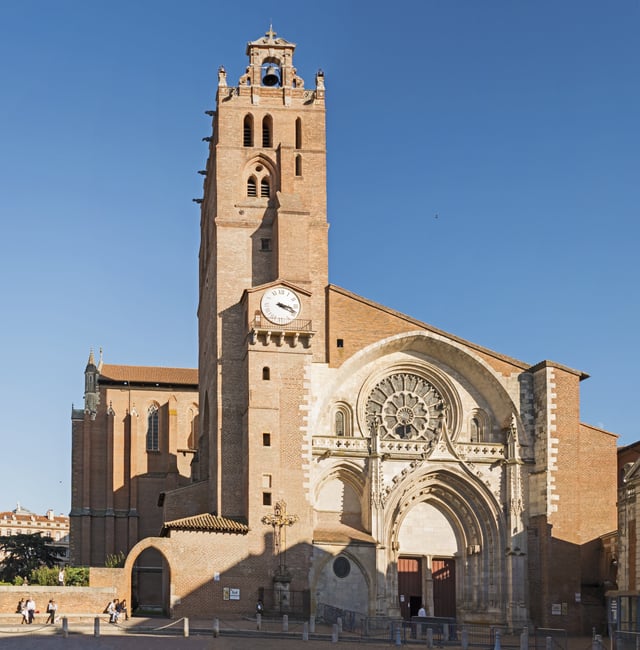
Toulouse Cathedral
The Capitole de Toulouse (mainly 18th century), houses the Hôtel de Ville (city hall), the Théâtre du Capitole (opera house), and the 16th-century Donjon du Capitole tower. It is located on the Place du Capitole. The Cité de l'espace (Space City) is a theme park of space exploration. The Médiathèque José Cabanis is a library. The Jardin des Plantes is a large park spanning several blocks, including a museum, cafés, activities for children and a botanical garden. Toulouse has many hôtels particuliers (large single-family homes usually enclosing an inner courtyard), the most significant being the Hôtel d'Assézat, which now houses five centuries of European art from the Renaissance to the 19th century.
The Bazacle is a ford across the Garonne river, built in the late 12th century and also used for hydroelectricity. The river is crossed by the Pont Neuf from the 16th century.
Religious buildings
Toulouse Cathedral is the seat of the Roman Catholic Archdiocese of Toulouse. Saint-Sernin Basilica, part of the Way of Saint James UNESCO World Heritage Site, is the largest Romanesque church in Europe. The Daurade basilica, of the 18th–19th century, was founded as a temple to the Roman god Apollo before conversion to Christianity in 410 AD. The Church of the Jacobins, (French: Ensemble conventuel des Jacobins) in Toulouse is the burial place of Saint Thomas Aquinas.
[[INLINE_IMAGE|//upload.wikimedia.org/wikipedia/commons/thumb/d/d4/Flag_of_Israel.svg/21px-Flag_of_Israel.svg.png|//upload.wikimedia.org/wikipedia/commons/thumb/d/d4/Flag_of_Israel.svg/32px-Flag_of_Israel.svg.png 1.5x, //upload.wikimedia.org/wikipedia/commons/thumb/d/d4/Flag_of_Israel.svg/41px-Flag_of_Israel.svg.png 2x|Israel|h15|w21|thumbborder flagicon-img flagicon-img]] Tel Mond, Israel, since 1987
Other cooperations
Toulouse also has accords of cooperation with the following towns:[42]
[[INLINE_IMAGE|//upload.wikimedia.org/wikipedia/en/thumb/9/9a/Flag_of_Spain.svg/23px-Flag_of_Spain.svg.png|//upload.wikimedia.org/wikipedia/en/thumb/9/9a/Flag_of_Spain.svg/35px-Flag_of_Spain.svg.png 1.5x, //upload.wikimedia.org/wikipedia/en/thumb/9/9a/Flag_of_Spain.svg/45px-Flag_of_Spain.svg.png 2x|Spain|h15|w23|thumbborder flagicon-img flagicon-img]] Zaragoza, Aragón, Spain
[[INLINE_IMAGE|//upload.wikimedia.org/wikipedia/commons/thumb/4/4b/Flag_of_Chad.svg/23px-Flag_of_Chad.svg.png|//upload.wikimedia.org/wikipedia/commons/thumb/4/4b/Flag_of_Chad.svg/35px-Flag_of_Chad.svg.png 1.5x, //upload.wikimedia.org/wikipedia/commons/thumb/4/4b/Flag_of_Chad.svg/45px-Flag_of_Chad.svg.png 2x|Chad|h15|w23|thumbborder flagicon-img flagicon-img]] N'Djamena, Chad
[[INLINE_IMAGE|//upload.wikimedia.org/wikipedia/commons/thumb/2/21/Flag_of_Vietnam.svg/23px-Flag_of_Vietnam.svg.png|//upload.wikimedia.org/wikipedia/commons/thumb/2/21/Flag_of_Vietnam.svg/35px-Flag_of_Vietnam.svg.png 1.5x, //upload.wikimedia.org/wikipedia/commons/thumb/2/21/Flag_of_Vietnam.svg/45px-Flag_of_Vietnam.svg.png 2x|Vietnam|h15|w23|thumbborder flagicon-img flagicon-img]] Hanoi, Vietnam
[[INLINE_IMAGE|//upload.wikimedia.org/wikipedia/commons/thumb/f/fd/Flag_of_Senegal.svg/23px-Flag_of_Senegal.svg.png|//upload.wikimedia.org/wikipedia/commons/thumb/f/fd/Flag_of_Senegal.svg/35px-Flag_of_Senegal.svg.png 1.5x, //upload.wikimedia.org/wikipedia/commons/thumb/f/fd/Flag_of_Senegal.svg/45px-Flag_of_Senegal.svg.png 2x|Senegal|h15|w23|thumbborder flagicon-img flagicon-img]] Saint-Louis, Senegal
[[INLINE_IMAGE|//upload.wikimedia.org/wikipedia/en/thumb/b/ba/Flag_of_Germany.svg/23px-Flag_of_Germany.svg.png|//upload.wikimedia.org/wikipedia/en/thumb/b/ba/Flag_of_Germany.svg/35px-Flag_of_Germany.svg.png 1.5x, //upload.wikimedia.org/wikipedia/en/thumb/b/ba/Flag_of_Germany.svg/46px-Flag_of_Germany.svg.png 2x|Germany|h14|w23|thumbborder flagicon-img flagicon-img]] Düsseldorf, Germany
See also
138 Tolosa, an asteroid
Roman Catholic Archdiocese of Toulouse
André Abbal
Listing of the works of Alexandre Falguière
The works of Antonin Mercié
List of the mayors of Toulouse




